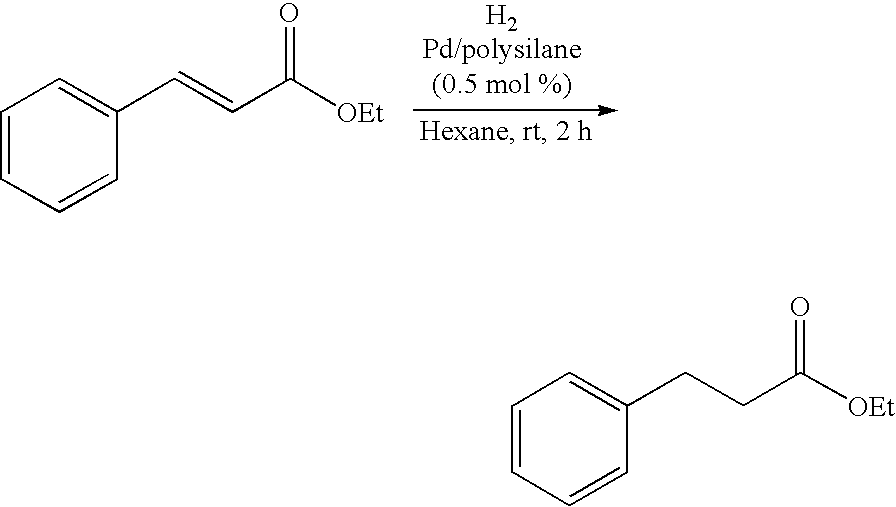Polysilane-Supported Transition Metal Catalyst
- Summary
- Abstract
- Description
- Claims
- Application Information
AI Technical Summary
Benefits of technology
Problems solved by technology
Method used
Image
Examples
examples
[0072]The following examples illustrate the present invention but it is not intended to limit the scope of the present invention. The molecular weight of polymers was determined by the use of Gel Permission Chromatography (GPC) system (SCL-1A, LC-10AD, RID-10A, CTO-10A, DGU-12A, column: shim-packg PC-803, 804, 8025; Shimazu Corp., Kyoto, Japan), tetrahydrofuran as a solvent and polystyrene as a standard for calibration curve. Infrared absorption spectra (IR) were measured by JASCO FT / IR Type-610 (JASCO Corp., Tokyo, Japan) using KBr tablet method. 1H-NMR and 13C-NMR were measured by JEOL JNM-EX-LA400 or JEOL JNM-EX-LA300 (JEOL Ltd., Tokyo, Japan) using deuterated chloroform as a solvent. Metal content in a polymer is determined by fuluorescent X-ray analysis (EDX-800; Shimazu) or inductively coupled plasma emission spectroscopy (ICP) (ICPS-7510; Shimazu). Gaschromatography (GC) was measured using GC-17A(Shimazu) and high speed liquid chromatography (HPLC) was measured using (SPD-10A...
example of preparation 1a
Preparation of Poly(methylphenylsilane)
[0073]Sodium metal (97 g, 4.2 mol) was added to refluxed tetrahydrofuran (1000 ml), then dichloromethylphenylsilane (2.0 mol) was dropped in 30 min. The mixture was stirred vigorously for 3 hr under reflux, then cooled to room temperature, and was cooled in ice bath. Three molarity of hydrochloric acid (500 ml) was added slowly after addition of toluene (500 ml) to decompose excess sodium. The upper phase (organic phase) was separated from the lower phase; was washed with water, 5% aqueous sodium bicarbonate, water, and saturated sodium chloride solution in order successively; and was dried on anhydrous sodium sulfate. After solubilization of the precipitated sodium chloride by adding water, the lower phase (water phase) was extracted by toluene. The extract was washed with 5% aqueous sodium bicarbonate, water, and saturated aqueous sodium chloride solution in order successively; and was dried on anhydrous sodium sulfate. Each desiccating agent...
example of preparation 1b
Preparation of Poly(Methylphenylsilane-Co-Diphenylsilane)
[0074]Sodium metal (97 g, 4.2 mol) was added to refluxed tetrahydrofuran (1000 ml), then tetrahydrofuran (200 ml) solution of dichloromethylphenyl silane (1.0 mol) and dichloro diphenylsilane (1.0 mol) was dropped in 40 min. The mixture was stirred vigorously for 3 hr under reflux, then cooled to room temperature, and was cooled in ice bath. The three molarity of hydrochloric acid (500 ml) was added slowly after addition of toluene (500 ml) to decompose excess sodium. The upper phase (organic phase) was separated from the lower phase; was washed with water, 5% aqueous sodium bicarbonate, water, and saturated aqueous sodium chloride solution in order successively; and was dried on anhydrous sodium sulfate. After solubilization of the precipitated sodium chloride by adding water, the lower phase (water phase) was extracted by toluene. The extract was washed with 5% aqueous sodium bicarbonate, water, and saturated aqueous sodium ...
PUM
| Property | Measurement | Unit |
|---|---|---|
| Mass | aaaaa | aaaaa |
| Substance count | aaaaa | aaaaa |
| Temperature | aaaaa | aaaaa |
Abstract
Description
Claims
Application Information
 Login to View More
Login to View More - R&D
- Intellectual Property
- Life Sciences
- Materials
- Tech Scout
- Unparalleled Data Quality
- Higher Quality Content
- 60% Fewer Hallucinations
Browse by: Latest US Patents, China's latest patents, Technical Efficacy Thesaurus, Application Domain, Technology Topic, Popular Technical Reports.
© 2025 PatSnap. All rights reserved.Legal|Privacy policy|Modern Slavery Act Transparency Statement|Sitemap|About US| Contact US: help@patsnap.com



